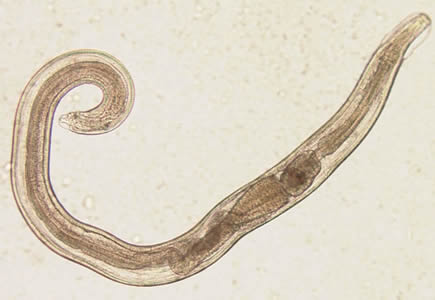- Pinworm
Taxobox
name = PinwormICD 127.4

image_width = 250px
image_caption = A pinworm ("Enterobius vermicularis").
regnum =Animal ia
phylum =Nematoda
classis =Secernentea
ordo =Rhabditida
familia =Oxyuridae
genus = "Enterobius"
genus_authority = Baird, 1853
subdivision_ranks = Species
subdivision = "Enterobius vermicularis " "Enterobius gregorii " ...The pinworm (Genus "Enterobius"), also known as threadworm is aparasitic roundworm of the phylumNematoda .Forms of worm
The best known is the human pinworm "
Enterobius vermicularis " and the more recently discovered "Enterobius gregorii ". The adult pinworm male is 1–4 mm in length, while the adult female is 8–13 mm and possesses the long, pin-shaped posterior for which the worm is named. The human pinworm is commonly found in children, but adults may also be affected.Habitat
The pinworm lives in the lower part of the
small intestine and the upper part of the colon. It is found worldwide, and causes the most common infectionenterobiasis in humans. Unlike many otherintestinal parasite s, the pinworm does not usually enter thebloodstream or any other organs besides the intestines. Only in rare cases pinworms are found in thevagina , and even more rarely in theuterus ,fallopian tube s,liver , andperitoneum , but the worms cannot survive long in these places.The human pinworm "Enterobius vermicularis" is a ubiquitous parasite of man, it being estimated that over 200 million people are infected annually. It is more common in the temperate regions of Western Europe and North America, (it being relatively rare in the tropics) and is found particularly in children. Samples of Caucasian children in the U.S.A. and Canada have shown incidences of infection of between 30% to 80%, with similar levels in Europe. [ [http://www.path.cam.ac.uk/~schisto/Nematodes/Enterobius.html The Human Pinworm] ]
Reproduction
After mating, the male dies. The female migrates to the
anus and emerges, usually during the night, to deposit about 10,000 to 20,000 eggs in the perianal area (around the anus). She then secretes a substance which causes a very strongitch ing sensation, inciting the host to scratch the area and thus transfer some of the eggs to the fingers. Eggs can also be transferred to cloth, toys, and the bathtub. Once ingested orally, the larvae hatch and migrate back to the intestine, growing to maturity in 30-45 days. The eggs can survive for 2 to 3 weeks on their own outside of the human body. In some cases, the larvae will hatch in the peri-anal area and travel back inside the anus, up the rectum, and back into the intestines where they mature. [Rudolph's Pediatrics - 21st Ed. 2003; Current Medical Diagnosis & Treatment - 45th Ed. 2006]Effects
Except for itching, pinworm infestation does not usually cause any damage to the body. Sleep disturbance may arise from the itching or crawling sensations. Some case reports suggest that severe infestation may be associated with an increased risk for
appendicitis . There is also some evidence of an association betweenenterobiasis and diminished zinc levels.Diagnosis
Diagnosis is often made clinically by observing the female worm (or many worms) in the peri-anal region, but can also be made using the
"scotch-tape" test , in which the sticky side of a strip ofcellophane tape is pressed against the peri-anal skin, then examined under a microscope for pinworm eggs.The actual worms may be seen in the host's faeces; however the eggs are invisible to the naked eye.
The diagnostic characteristics are: size 50-60 µm by 20-32 µm; typical elongated shape, with one convex side and one flattened side and colorless shell [cite web | url = http://pathmicro.med.sc.edu/parasitology/nematodes.htm| title =PARASITOLOGY - CHAPTER FOUR NEMATODES (Round Worms) | accessdate = 2007-10-18| publisher = The Board of Trustees of the University of South Carolina] .
On histologic
cross-section , alae or wings (running the length of the worm) are identifying features of the pinworm (see micrograph). [Diagnostic Findings Enterobiasis.Centers for Disease Control and Prevention . URL: [http://www.dpd.cdc.gov/dpdx/HTML/Enterobiasis.htm http://www.dpd.cdc.gov/dpdx/HTML/Enterobiasis.htm] . Accessed on: August 6, 2008.]Treatment
Anti-pinworm drugs such as Albenza (
albendazole ), Vermox (mebendazole )/ OVEXtm(mebendazole ),Piperazine and Pin-X or Reese's Pinworm Medication (pyrantel pamoate ) are commonly used to treat pinworms as well asascaris lumbricoides (the roundworm). It is not a necessity to visit a doctor to get these drugs, as Pin-X is available as an over-the-counter medication (Albenza and Vermox are prescription in the US); ask a pharmacist for medicines to treat pinworms (or threadworms as they are known in the UK). These medicines kill the pinworms 95% of the time, but do not kill the eggs. The person being treated may have to return after a time of two weeks to be re-treated. Another precaution is to wash the hands before eating (to prevent any pinworm eggs under fingernails from being ingested) and to wash any area or clothes which have touched or been in the vicinity of the infected areas. Treating the entire family is often necessary for cure.
=Additionalee also
*
List of parasites (human) References
External links
* [http://content.nejm.org/cgi/content/full/354/13/e12/DC1 New England Journal of Medicine Video of infected colon]
* [http://www.nhsdirect.nhs.uk/articles/article.aspx?articleId=362 NHS Direct Health encyclopaedia - Threadworms]
* [http://experience.patient.co.uk/discussion_list.php?d=391 Experiences about Threadworm (Patient UK forum)]
Wikimedia Foundation. 2010.
